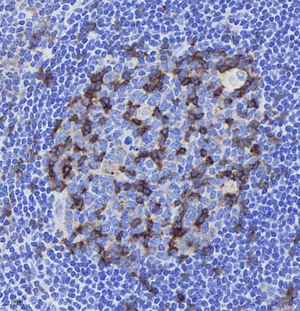| Reactivity: | H |
| Applications: | IHC/IF |
| Host Species: | Mouse |
| Clonality: | Monoclonal |
| Gene Name: | Programmed cell death protein 1 (Protein PD-1) (hPD-1) (CD antigen CD279) |
Gene ID: | 5133 |
Immunogen: | Synthesized peptide derived from human PD-1 |
Uniprot ID: | Q15116 |
Source: | Mouse/IgG1, Kappa |
Concentration: | 1 mg/ml |
Purity: | The antibody was affinity-purified from mouse ascites by affinity-chromatography using specific immunogen. |
Product Usage Information
IHC/IF | Human | 1: 200-1: 500 | tonsil |
Background
Programmed cell death 1 (PD-1, also known as CD279) is an immunoinhibitory receptor that belongs to the CD28/CTLA-4 subfamily of the Ig superfamily. It is a 288 amino acid (aa) type I transmembrane protein composed of one Ig superfamily domain, a stalk, a transmembrane domain, and an intracellular domain containing an immunoreceptor tyrosine-based inhibitory motif (ITIM) as well as an immunoreceptor tyrosine-based switch motif (ITSM). PD-1 is expressed during thymic development and is induced in a variety of hematopoietic cells in the periphery by antigen receptor signaling and cytokines . Engagement of PD-1 by its ligands PD-L1 or PD-L2 transduces a signal that inhibits T-cell proliferation, cytokine production, and cytolytic function.
Images
|
Immunohistochemistry analysis of paraffin embedded human tonsil using PD1 (GB14131) at dilution of 1: 100 |
Storage
| Storage | Store at -20°C for one year. Avoid repeated freeze/thaw cycles. |
| Storage Buffer | Liquid in PBS containing 50% glycerol, 0.5% BSA and 0.02% sodium azide. |

